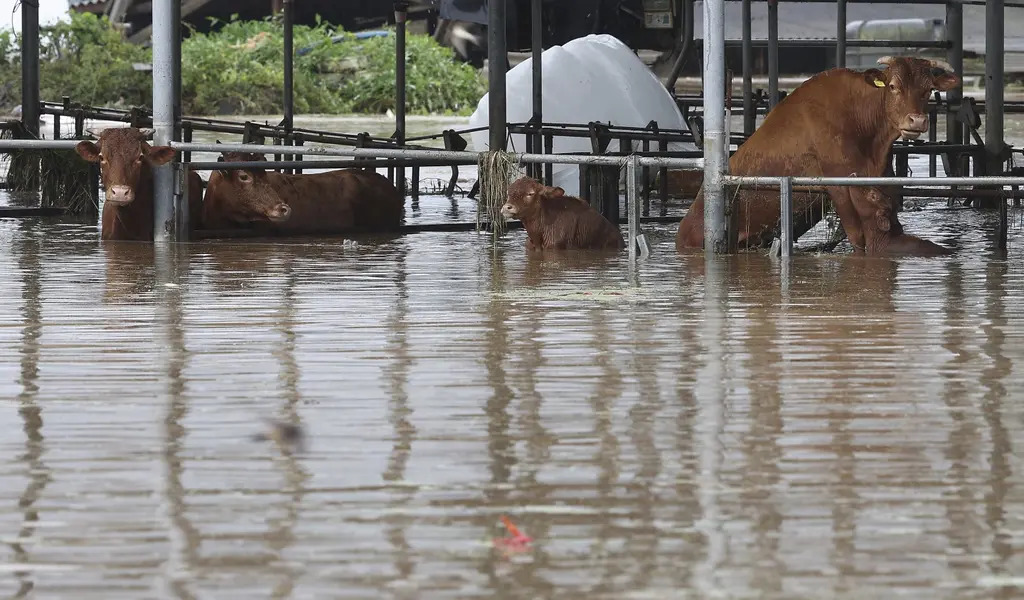News
South Korea Hosts Massive K-Pop Concert For Scouts Following Jamboree Disruption By Storm Khanun

(CTN NEWS) – Amidst the aftermath of a formidable tropical tempest that inundated numerous residences and transformed thoroughfares into turbid streams.
The realm of South Korea orchestrated an immense K-Pop gala within Seoul’s precincts, an endeavor intended for the assembly of 40,000 Scouts whose worldwide Jamboree had been subject to disturbance courtesy of atmospheric caprice.
Amidst the Veil of Meteorological Turmoil, Emerges a Rain-Soaked Showcase of Talent
The event, transpiring on the day subsequent to the meteorological maelstrom, transpired upon a rain-soaked soccer stadium, boasting an array of performers, most notably the female ensembles NewJeans and Ive.
This impromptu spectacle was meticulously orchestrated by government functionaries, etching its position as the culminating convocation in the panorama of the World Scout Jamboree.
This orchestration found its footing within the juncture wherein the nation commenced the endeavor of restoration and reinstatement, endeavoring to rectify the repercussions of tempestuous Khanun.
An inclement manifestation that unleashed relentless precipitation and gusty zephyrs upon the southern and eastern extremities of the landmass, catalyzing mass evacuations and claiming a solitary life in its wake subsequent to its initial terrestrial encounter on the threshold of Thursday.
As Khanun embarked upon its traverse through the Seoul metropolitan terrain, an agglomeration teeming with human activity, it had attenuated, consequently permeating the ambiance as a tropical low pressure system.
Early Friday, the meteorological semblance ventured into the confines of North Korea, its essence diluted to that of a tropical depression.
The once-proximate coastline, which served as the vantage point for the Jamboree, succumbed to the tempestuous surges precipitated by Khanun, necessitating a grand-scale exodus to transition the Scouts from their initial encampment to the alcoves of university lodging, governmental and corporate edification centers, and lodgings within the expanse of greater Seoul and its environs.
Preceding the storm’s forceful truncation of the Jamboree’s continuum, the organizers found themselves ensnared in a struggle to sustain the event amidst an unforgiving heatwave and dilemmas pertaining to sanitation.
South Korea Setback in Public Relations: Withdrawals Cast Shadow on the Nation’s International Aspirations
These quandaries led to a premature departure of several British and American Scouts from the encampment.
Such withdrawals marked a momentous public relations setback for the nation, ceaselessly yearning for the spotlight that accompanies grand-scale international gatherings.
The Friday concert emerged as a culmination of feverish governmental endeavors, a concerted bid to bestow a fitting denouement upon the Jamboree’s narrative.
“Regretfully, we acknowledge the tribulations the Scouts faced amid an unparalleled heatwave and the tempestuous onslaught borne from the tenets of climate change,” intoned South Korean Prime Minister Han Duck-soo in a prelude to the concert, gracing the expanse of Seoul’s World Cup Stadium with his oratory prowess.
Resplendent Mosaic: Global Scouts Eclipse Prime Minister’s Utterances
Yet, his utterances found themselves somewhat eclipsed by the massive throng of global Scouts, resplendent in their multicolored uniforms and raincoats, a mosaic of vibrancy that filled the stadium’s seats.
In rapturous synchrony, they reverberated with exuberance, engendering a crescendo of euphoria that swelled and surged, mirroring the waves of excitement undulating through the venue, synchronous with the rhythm of Han’s vocal cadence.
In the liminal moment when the vocalists graced the brightly illuminated stage, the precipitation’s delicate drizzle lent an ethereal aura to the tableau.
In harmonious tandem, the Scouts brandished heart-shaped luminous wands, crafting an iridescent tapestry that interwove with the beams of light.
Their devices, instruments of modernity, were employed to capture the ephemeral, rendering the performance an indelible fragment of their recollections.
The gubernatorial apparatus asserted the majority of aerial and rail conveyances had resumed operations, with power largely reinstated to the 46,000 domiciles ensnared in Khanun’s electric embrace.
The urban expanse of Seoul remained devoid of calamitous tempestuous scars, notwithstanding the persisting precipitation that bestowed its aqueous benedictions upon the cityscape.
Incheon’s Resurgence: Laborers Strive to Restore Deluged Abodes and Walls
Conversely, in the proximate harbor city of Incheon, laborers embarked upon a restorative endeavor, a rejoinder to inundated abodes and walls whose structural integrity had succumbed to Khanun’s aqueous deluge.
Within the southern recesses of the inland city of Daegu, a septuagenarian gentleman, ensnared in the embrace of a bloated stream, met his untimely demise.
In parallel, the search persisted for an individual, entrapped in the clutches of a watercourse, while occupying a conveyance of wheels.
In the precincts of Gangwon province, an orographic bastion along the eastern seaboard that bore the brunt of Khanun’s torrential affections, emergency responders embarked upon aquatic odysseys within the coastal towns of Gangneung and Sokcho.
Here, rivers of sepia-hued torrents usurped the thoroughfares, cloaking erstwhile streets in aqueous vestiges.
In a symphonic choreography, nearly 16,000 souls, predominantly inhabitants of the southern demesnes, found themselves coerced into the embrace of evacuation, a temporary egress precipitated by the tempest’s fervor.
As the sun waned upon the horizon, the Ministry of the Interior and Safety reported that approximately 11,400 had retraced their steps homeward.
Khanun’s malevolent touch had marred or razed no less than 64 roadways, while also exacting a toll upon nearly 50 abodes and edifices. The transportation grid was imperiled, with access to nearly 700 motorways circumscribed as the rains perpetuated their descent.
In the enigmatic realm of North Korea, prompt confirmation of the storm’s consequential impact remained elusive.
Albeit, the state-controlled television did proffer acknowledgment of some uprooted arboreal sentinels.
Preceding the tempestuous event, the annals of state media had meticulously delineated nationwide initiatives, marshaling resources to fortify the guardianship of highways, railways, spans, and coastlines.
Simultaneously, machinations had been set in motion to shield factory machinery and cultivate copious crops against the tempest’s capricious whims.
RELATED CTN NEWS:
IRCC introduces New Approved English Language Tests For Student Direct Stream (SDS) Applicants



























